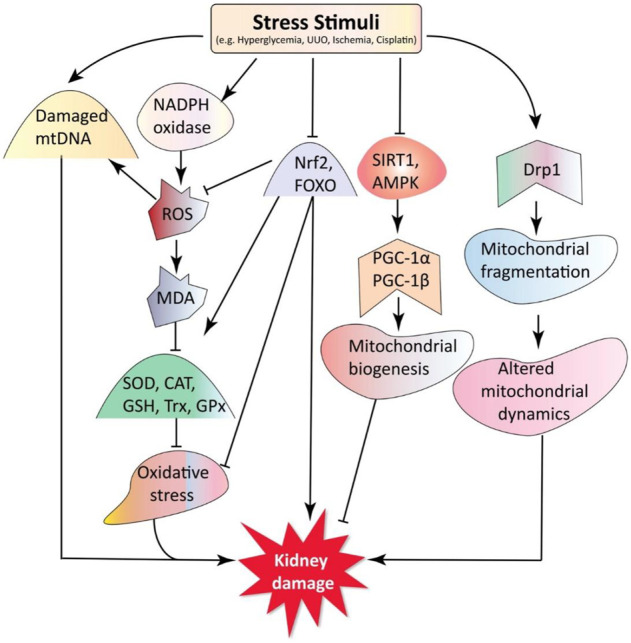FIGURE 1.

Mitochondria dysfunction in kidney diseases. Stress stimuli, such as hyperglycemia (HG), unilateral ureteric obstruction (UUO), cisplatin, and ischemia cause an imbalance between oxidative stress and antioxidants. Under stress stimuli, the expression of transcription factors nuclear factor erythroid 2-related factor 2 (Nrf-2) and forkhead box O (FOXO) decreases, activating nicotinamide adenine dinucleotide phosphate (NADPH) oxidase leading to excessive ROS and malondialdehyde (MDA) production. This oxidative stress also reduces the transcription of antioxidants such as superoxide dismutase (SOD), catalase (CAT), glutathione synthetase (GSS), glutathione peroxidase (GPX), and thioredoxin (Trx). Sirtuin 1 (SIRT1) and AMP-activated protein kinase (AMPK) can activate peroxisome proliferator-activated receptor γ coactivator 1α (PGC-1α), a master regulator of mitochondrial biogenesis. The activated dynamin-related protein 1 (Drp1) disturbs mitochondrial dynamics and causes mitochondria fragmentation. Moreover, various stress stimuli can induce mtDNA damage. Altogether, these cause changes in mitochondria structure and function, exacerbating kidney disease progression. Key: AMPK, AMP-activated protein kinase; CAT, catalase; DN, diabetic nephropathy; Drp1, dynamin-related protein 1; FOXO, forkhead-box class O; GSH, glutathione; GPx, glutathione peroxidase; GM, gentamycin; HN, hyperuricemic nephropathy; MDA, malondialdehyde; mtDNA, mitochondrial DNA; PGC-1α, peroxisome proliferator-activated receptor-γ coactivator 1α; ROS, reactive oxygen species; SIRT1, silent mating type information regulation 2 homolog 1; SOD, superoxide dismutase; Trx, thioredoxin; UUO, unilateral ureteral obstruction.
